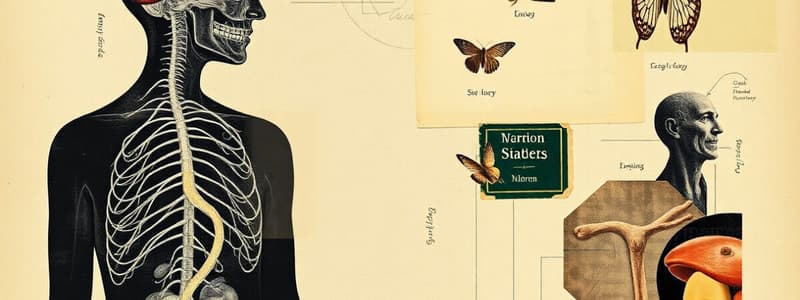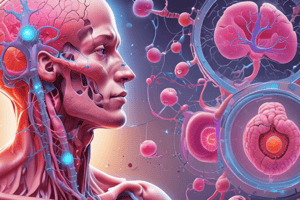Podcast
Questions and Answers
Which of the following best describes the primary role of body systems in responding to a stimulus?
Which of the following best describes the primary role of body systems in responding to a stimulus?
- To prioritize immediate survival responses over long-term stability.
- To amplify the effects of external stimuli on the body.
- To maintain a stable internal environment through coordinated regulation. (correct)
- To independently react to external changes without coordination.
Homeostasis refers to the body's ability to maintain a completely static internal environment, without any fluctuations.
Homeostasis refers to the body's ability to maintain a completely static internal environment, without any fluctuations.
False (B)
Define the term 'homeostasis' and briefly explain its significance for the human body.
Define the term 'homeostasis' and briefly explain its significance for the human body.
Homeostasis is the maintenance of a stable internal environment in the body. It is crucial for optimal cell function and survival.
_______ glands secrete hormones directly into the bloodstream, affecting various bodily functions.
_______ glands secrete hormones directly into the bloodstream, affecting various bodily functions.
Match the following glands with their respective secretion method:
Match the following glands with their respective secretion method:
Which of the following is an example of an exocrine gland?
Which of the following is an example of an exocrine gland?
The primary function of hormones is to transport nutrients throughout the body.
The primary function of hormones is to transport nutrients throughout the body.
Describe the main function of the human reproductive system.
Describe the main function of the human reproductive system.
In males, sperm is produced in the _______.
In males, sperm is produced in the _______.
Match the following male reproductive structures with their functions:
Match the following male reproductive structures with their functions:
In females, where does fertilization typically occur?
In females, where does fertilization typically occur?
The uterus is where the egg is produced in females.
The uterus is where the egg is produced in females.
What is ovulation, and where does the released egg travel?
What is ovulation, and where does the released egg travel?
After fertilization, the egg implants in the _______, where it develops into a fetus during pregnancy.
After fertilization, the egg implants in the _______, where it develops into a fetus during pregnancy.
Match the following hormones with their primary role in regulating the menstrual cycle:
Match the following hormones with their primary role in regulating the menstrual cycle:
Which hormone is primarily responsible for the development of male secondary sexual characteristics?
Which hormone is primarily responsible for the development of male secondary sexual characteristics?
The menstrual cycle is directly regulated by testosterone levels.
The menstrual cycle is directly regulated by testosterone levels.
Explain the role of feedback mechanisms in maintaining homeostasis.
Explain the role of feedback mechanisms in maintaining homeostasis.
The ______ system is one of the major systems that is involved in regulating and coordinating the body’s response to a stimulus.
The ______ system is one of the major systems that is involved in regulating and coordinating the body’s response to a stimulus.
Match the component of the female reproduction system with the action that occurs there.
Match the component of the female reproduction system with the action that occurs there.
Flashcards
Homeostasis
Homeostasis
Maintenance of a stable internal environment despite external changes.
Glands
Glands
Organs that produce and secrete substances.
Endocrine Glands
Endocrine Glands
Glands that secrete hormones directly into the bloodstream.
Hormones
Hormones
Signup and view all the flashcards
Exocrine Glands
Exocrine Glands
Signup and view all the flashcards
Human Reproduction System
Human Reproduction System
Signup and view all the flashcards
Testes
Testes
Signup and view all the flashcards
Ovaries
Ovaries
Signup and view all the flashcards
Fertilization
Fertilization
Signup and view all the flashcards
Uterus
Uterus
Signup and view all the flashcards
Estrogen and Progesterone
Estrogen and Progesterone
Signup and view all the flashcards
Vas Deferens
Vas Deferens
Signup and view all the flashcards
Fallopian Tubes
Fallopian Tubes
Signup and view all the flashcards
Ovulation
Ovulation
Signup and view all the flashcards
Follicle-Stimulating Hormone (FSH) and Luteinizing Hormone (LH)
Follicle-Stimulating Hormone (FSH) and Luteinizing Hormone (LH)
Signup and view all the flashcards
Study Notes
- Body systems regulate and coordinate responses to stimuli to maintain internal balance
- Coordination involves the nervous system, the endocrine system, and other organ systems.
Homeostasis
- Homeostasis is the maintenance of a stable internal environment, despite external changes
- Feedback mechanisms detect deviations and trigger responses to counteract them.
Glands
- Glands produce and secrete various substances
- Endocrine glands secrete hormones directly into the bloodstream
- Hormones regulate bodily functions, including growth, metabolism, and reproduction.
- Exocrine glands secrete substances through ducts onto body surfaces or into body cavities
- Examples include sweat glands, salivary glands, and digestive glands.
Human Reproduction System
- The human reproduction system makes offspring
- In males, the testes produce sperm and testosterone
- Sperm travels through the vas deferens, ejaculatory duct, and urethra during ejaculation.
- In females, the ovaries produce eggs and estrogen
- Eggs are released during ovulation and travel through the fallopian tubes to the uterus.
- Fertilization occurs when a sperm fuses with an egg in the fallopian tube
- The fertilized egg implants in the uterus, where it develops into a fetus during pregnancy.
- Hormones regulate the menstrual cycle and pregnancy
- These include estrogen, progesterone, follicle-stimulating hormone (FSH), and luteinizing hormone (LH).
Studying That Suits You
Use AI to generate personalized quizzes and flashcards to suit your learning preferences.




